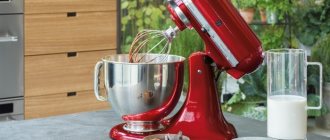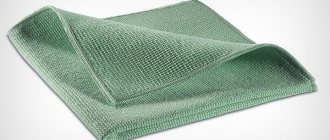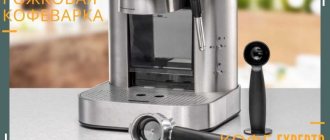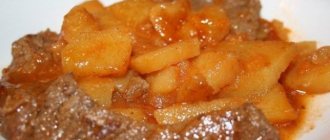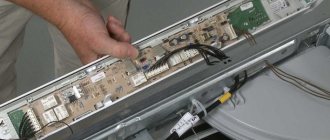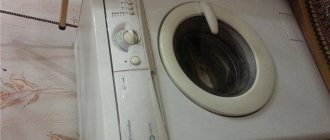Geyser coffee makers are probably familiar to many from the times of the USSR; at that time they were made of aluminum and therefore very quickly lost both their appearance and quality characteristics. Such devices are most widespread in Italy, the famous Italian “mocha” - these are, in fact, the same geyser versions, only in a more interesting and varied design. Let's try to understand the operating principle of a geyser coffee maker by studying some of the features of its functioning.
What is a geyser coffee maker
A geyser coffee maker prepares a delicious, aromatic drink using steam. The device is a prefabricated vessel consisting of two parts. Water boils at the bottom of the device, and the filter between them contains ground coffee. The powder, under the influence of steam coming from below through a special internal spout in the filter (the part separating the top and bottom), is brewed, turning into a strong drink. The upper vessel is also a container for ready-made coffee. There is a safety valve on the bottom of the device through which excess pressure can be released. Externally, the geyser coffee maker resembles a tall, slender teapot. Traditionally, such devices have a faceted vessel design.
Geyser coffee makers come in several types. The first and simplest is slab. They can be used on gas and electric stoves. The process of making coffee is simple and does not require the skill of a barista. Just pour water down, pour ground coffee up, and put the structure on fire. When a characteristic hiss appears, you can remove the device from the stove and enjoy the aromatic, freshly brewed drink.
Electric coffee makers operate from the mains. They cost more, but they are also more convenient to use. There is already a thermostat, automatic shutdown, indication and a power off button, which allows you not to remove the cord from the outlet every time. Advanced models have additional options: indication on the display, adjusting the coffee strength, keeping warm, wireless operation and others.
Induction cooker coffee makers are essentially the same as the first devices. The only difference is that induction coffee makers have a magnetic bottom and are compatible with induction cooktops. In such a coffee maker you can prepare a drink on any type of stove; they are universal. But on the contrary, it is not always possible to brew a drink using induction in a device designed for a gas stove.
Attention: if there is no special marking on the coffee maker, you can check its magnetic properties yourself. If any magnet is “glued” to the bottom, such a device is suitable for induction.
Electrical modifications
Along with the classic versions that use an external “coolant,” there are electric geyser coffee makers on sale that are equipped with a built-in heating element and operate like a kettle with a stand. On the latter, they can rotate around their axis.
In addition to the most obvious advantage, that there is no need to fire up the stove, there is also a corresponding disadvantage - it is necessary to have electrical power. Another inconvenience is that you cannot quickly “recharge” the coffee maker and prepare another portion, since you have to wait until it cools down, and rinsing the electric version with cold water is problematic.
The electric version is, of course, more expensive, but it may (or may not, depending on the model) have a timer to start cooking. Allegedly, the smell of coffee can wake you up for work in the morning instead of an alarm clock.
Coffee maker device
The structure of a household geyser coffee maker looks like this:
- At the base of the device there is a water container, into the wall of which a safety (emergency) valve is built in.
- A filter is placed on the container, the entire perimeter of which is covered with a mesh - a kind of strainer for ground coffee.
- At the top of the coffee maker there is a compartment (vessel) for the finished drink.
Geyser coffee maker device
Useful tips
The following recommendations will help you prepare high-quality coffee in a geyser coffee maker:
- It is better to grind the grains immediately before starting cooking. It is better to choose a coarse grind;
- Purified water should be poured in. The quality of the liquid significantly affects the taste;
- You need to wash the coffee pot after each use;
- the more tightly the raw material is compacted, the richer the espresso is;
- It is advisable to pour the prepared drink into warm cups;
- if the result is excessively weak, liquid coffee, you should take beans that are crushed to a greater extent;
- the appearance of sediment in the drink indicates the need to use coarse ground beans.
How does it work
The operating principle of the device is based on the use of steam under pressure. A certain amount of water is poured into the lower compartment of the housing. Using the mark inside the coffee maker, it is necessary to clearly monitor the filling level, preventing the water level from rising above the permissible level. Coffee powder is poured into the coffee compartment, after which the upper part of the device is screwed on and the device is put on fire.
During the boiling process, water turns into steam, squeezing out the remaining liquid through the tube into the upper compartment, after passing it through the coffee.
Since geyser coffee makers are used primarily for making espresso, the principle of operation comes down solely to the “squeezing out” function of steam. If the steam is also brewed, the temperature of the product at the outlet will be too high.
We bring to your attention a video demonstrating in detail how a geyser coffee maker works.
A special role in the device is given to the emergency valve. With its help, the pressure stops when the tube becomes clogged and water cannot pass through it. This can happen if you use compacted coffee that is too finely ground, in which case all the water will escape through the steam into this valve.
Emergency valve for Bialetti coffee maker. Photo: mokapot.ru
Peculiarities
The geyser type of coffee maker involves using only medium and coarse grinding powder. It is highly not recommended to use unfiltered water (for example, from a tap); natural purified water (bottled, etc.) is best suited. You should check whether the rotating parts of the device are tightly screwed in (tightness is very important, because pressure builds up in the system). Of course, it is necessary to grind coffee beans immediately before cooking, and not in advance, because they may lose their aromatic properties.
Well, the last, but no less important feature - under no circumstances should you open the device until it notifies you of cooking, this can lead to burns.
How to prepare a drink in a geyser coffee maker
Usually the coffee maker comes with a user manual, which describes in detail the process of making coffee. Let's look at the process step by step.
- Remove the coffee maker top and filter.
- Pour water into the lower container. It is important to observe the “maximum” mark and not overfill.
- Add ground coffee and spices to the filter. The edges were wiped clean of coffee. Reinstall the filter.
- Completely assemble the coffee maker.
- Put the device on fire or press the electric power button.
- On the stove, coffee is brewed over low heat. Readiness is checked as follows: water stops flowing into the upper container - you can remove the coffee maker from the heat.
- That's it, you can enjoy your drink.
- To prepare the next portion of coffee, the device must be rinsed and the entire algorithm repeated again.
Please note: the device becomes very hot during coffee preparation. If touched, serious burns may occur. You can only take the coffee maker by the handle to pour the drink into cups. It doesn't heat up.
Selection rules
To purchase a high-quality unit that meets all requirements, you need to consider several important points when choosing:
- A type of coffee pot . An electric coffee maker is more expensive than the classic model, but is more convenient to use. At the same time, using a simple device on a gas stove, you can prepare a drink even in the absence of electricity.
- Volume. Making coffee in a geyser coffee maker has one feature that cannot be ignored when purchasing a device. In a coffee pot you can prepare exactly the number of servings at a time for which it is designed. Therefore, this criterion is extremely important to take into account.
- Unit handle. Made from metal it will get very hot. It is recommended to give preference to heat-resistant materials.
- The presence of a mark in the lower container intended for water.
- Lid. It is more convenient to use devices with a transparent cover. Thanks to this, it will be possible to visually determine the degree of readiness of the drink.
- Material . Most often, coffee makers are made of aluminum. This material has one drawback - it changes the taste of coffee. Preference should be given to steel and glass-ceramic structures.
- Availability of additional functions . Some models are equipped with a built-in coffee grinder, timer, and power indicator.
Recommendations for use
It is important to follow the operating rules in order to brew wonderful coffee and avoid premature breakdown of the device. Carefully monitor the temperature of your gas or electric stove. As soon as you hear that the drink begins to leak into the upper compartment (this can easily be guessed after a few days of operation), turn off the burner, and in the case of an electric stove, it is better to remove the device from it altogether.
You shouldn’t compact the coffee too hard, even if you want to get a rich drink: just lightly press the mass with a teaspoon. Do not let the operating appliance start to “snort”; this can happen during the final stages of cooking. If you do hear such sounds, immediately pour cold water over the lower part of the body. “Snorting” means that too hot steam begins to participate in the work, this affects the quality and flavor notes of the finished drink.
Popular misconception #2.
Many buyers think that they can make the coffee in a geyser coffee maker less strong by simply putting less ground coffee in the filter funnel.
Unfortunately, it is not. That’s why it’s so important to choose the right volume when buying a coffee maker.
If you put in less coffee than the specified volume, then the water will follow the path of least resistance - it will wash its “path” between the ground coffee. As a result, the output will be slightly tinted bitter (due to overextraction) coffee water. See visual photo:
Therefore, the coffee filter must be completely filled, even just a little bit. Then the operating principle will be followed and the coffee tablet will create uniform resistance to water, and you will get a rich drink. And when using freshly ground coffee, preferably containing robusta, you will even get real coffee crema.
Care
It is important to properly care for a geyser-type coffee maker. This will allow you to brew a high-quality drink with a pure taste and high quality. In addition, a well-maintained product will last much longer, given the simple design; such coffee makers are often passed down from generation to generation.
- Before turning on/placing the coffee maker on the stove, you need to check the correctness of its assembly, the tightness of the connections, and the tightness.
- Do not place a hot device under cold water to wash it. The coffee maker must first be cooled.
- Be sure to clean the safety valve. A clogged valve will not be able to release excess pressure and the coffee maker may explode.
- The filter must be washed using detergent or soda.
- The filter and gaskets should be inspected for wear and defects before each use.
- The coffee maker and any of its parts should not be washed in the dishwasher.
- To avoid corrosion, all parts of the device must be dried after washing.
- Stovetop coffee makers should not be placed on high heat.
Attention: over time, a deposit of coffee essential oils forms on the walls of the coffee maker. It does not need to be scraped or cleaned. It works as a protective film, protecting the aroma of coffee from foreign odors. The coffee maker is easy enough to wash like regular dishes.
History of invention
Coffee makers of this type were invented in the first half of the last century. In 1933, the production of two-tier metal coffee pots was launched. They were invented by the Italian Alfonso Bialetti.
The first mass-produced model was sold under the Moka Express brand. A coffee pot with an octagonal aluminum body appeared in almost every Italian family, and it is still one of the symbols of Italy. Now the company, founded by an Italian, continues to produce utensils for brewing coffee under the Bialetti brand.
Additional functions
Geyser-type coffee makers with the simplest operating principle are designed, first of all, for preparing a tasty and high-quality drink. However, in some more advanced models, manufacturers offer an additional set of functions that significantly facilitate the operation process.
Among them:
- Availability of a sound notification when the process is completed.
- Light indication confirming or refuting the operation of the device.
- A timer with which you can independently set the time for automatic switching on of the device.
- Automatic shut-off when the drink is ready and a warming function that allows you to maintain the temperature of the coffee.
Popular misconception #1.
Contrary to popular belief, in a geyser coffee maker, steam does not pass through the coffee. Steam is only needed to create pressure. Hot water passes through the coffee at a temperature just below 100 °C.
Fans of geyser coffee makers conducted an experiment, measuring the temperature of coffee and water during operation *. It turned out that the brewing temperature starts at about 65 °C (the first drops of coffee) and then gradually increases, exceeding 95 °C only at the very last moment.
This is exactly the moment when a geyser-type coffee maker begins to “spit” coffee with a characteristic hissing sound. Boiling water only imparts an unpleasant bitterness to coffee, so it is recommended to remove the coffee pot from the stove before this point:
Advantages and disadvantages
Main advantages:
- The richness and aroma of the finished drink.
- There is no need to constantly monitor the operation of the device (as, for example, in the case of a Turk).
- Ready-made coffee does not have the so-called “grounds”, since there is no possibility of sediment getting into the upper bowl.
- Acceptable cost of the device. Even the original Italian-assembled Bialetti Moka Express costs no more than 2-3 thousand rubles. Chinese models, of course, are even cheaper.
- Compact, allowing you to place the device anywhere.
- The geyser can be used not only for making coffee, but also for brewing teas and herbal infusions.
Minuses:
- Limitation to a clearly defined volume - you need to prepare a strictly designated number of cups, no more and no less.
- It is necessary to carefully monitor the degree of grinding of the powder; it should not be too fine, otherwise the filter may become clogged.
- The structure of the device can cause certain difficulties when caring for it.
- It is impossible to get an appetizing foam.
- The metal part of the coffee maker remains hot for a long time after switching off, so care must be taken when handling the device.
- If you have an induction hob at home, then the most popular aluminum geyser coffee makers will not work on it. You will have to look for steel coffee pots, for example, Bialetti Venus.
Thus, when choosing a geyser-type coffee maker, you should carefully evaluate all its advantages and disadvantages in order not to be disappointed later either in the set of possible functions, or in the principle of operation, or in the quality of the finished drink.
Where are they made?
The original Bialetti is now produced in both Europe and Asia: there are factories in their native Italy, Romania, Turkey, India and China.
As far as I know, the classic Bialetti Moka Express (from 1,534 rubles) is still assembled in Italy, but the painted (colored) “express” ones are already from Romania. The Brikka and Fiammetta series are also assembled there (from RUB 2,000).
And the most inexpensive of the original Bialetti Junior (from 1000 rubles) is from China, like Bialetti Venus and Allegra . The Indians got the Kitty (although Ozone claims that this is Italy), but Kitty is also made in China. The Turkish factory makes accessories (for example, frothers) and some electric models.
By the way, you can buy a geyser coffee maker not in any household appliances store. I hope my selection of current prices (updated automatically 3 times a day) at the end of the article will help you navigate online hypermarkets.
